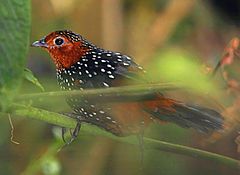Rhinocryptidae
| Tapaculos | |
|---|---|
 |
|
| Ocellated tapaculo, Acropternis orthonyx | |
| Scientific classification | |
| Kingdom: | Animalia |
| Phylum: | Chordata |
| Class: | Aves |
| Order: | Passeriformes |
| Suborder: | Tyranni |
| Family: |
Rhinocryptidae (but see below) Wetmore, 1930 |
| Genera | |
| Synonyms | |
|
Pteroptochidae |
|
Pteroptochidae
The tapaculos (pronounced /tæpəˈku:ləʊ/) are a group of small suboscine passeriform birds with numerous species, found mainly in South America and with the highest diversity in the Andean regions. Three species (Chocó, Tacarcuna, and the silvery-fronted) are found in southern Central America.
Tapaculos are small to medium-sized birds, with a total length ranging from 10–24 cm (4–9½ in). These are terrestrial species that fly only poorly on their short wings. They have strong legs, well-suited to their habitat of grassland or forest undergrowth. The tail is cocked and pointed towards the head, and the name tapaculo possibly derives from Spanish for "cover your behind". Another possible explanation is that it originates from the Chilean name for the white-throated tapaculo, simply tapaculo, which is an onomatopoeic reference to its commonly heard song.
While the majority of the family are small blackish or brown birds there are some larger and more colourful species. All tapaculos are skulking birds that frequently stay low in dense vegetation, even the larger, colorful species, and this renders them difficult to see. They are best located and – in the case of Scytalopus spp. – identified by their vocalisations.
They feed on insects, seeds and other soft plant material with their pointed bills, and will scratch on the ground like a pheasant.
Most species lay two or three white eggs in a covered location, whether it be a burrow, a hole in a tree, or a domed nest.
Some species have highly localized distributions and, being poor fliers, they easily become isolated in small populations. BirdLife International currently (2007) consider one species vulnerable (Scytalopus panamensis), three species endangered (S. iraiensis, S. rodriguezi and S. robbinsi), and two species critically endangered (Eleoscytalopus psychopompus and Merulaxis stresemanni). The two critically endangered species are restricted to Atlantic forest of eastern Brazil, and were only recently rediscovered after several years without any records.
...
Wikipedia
